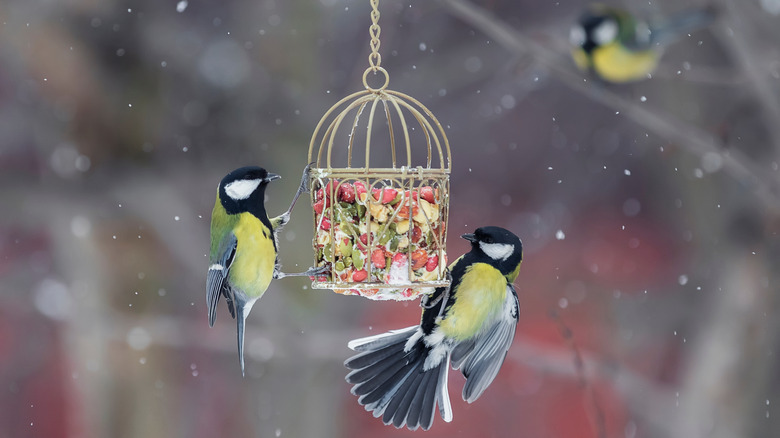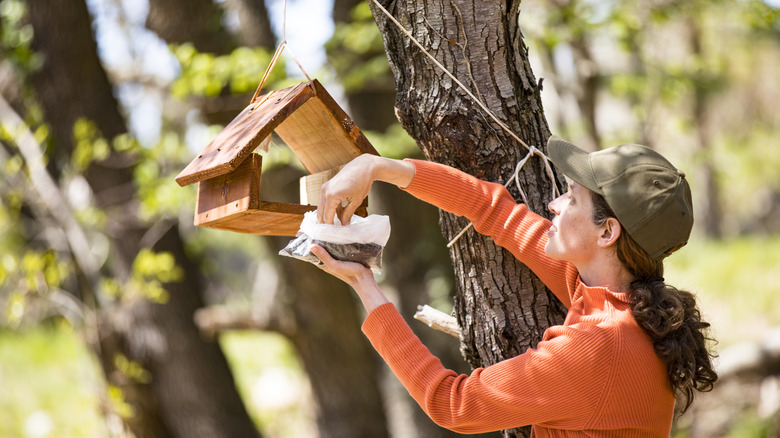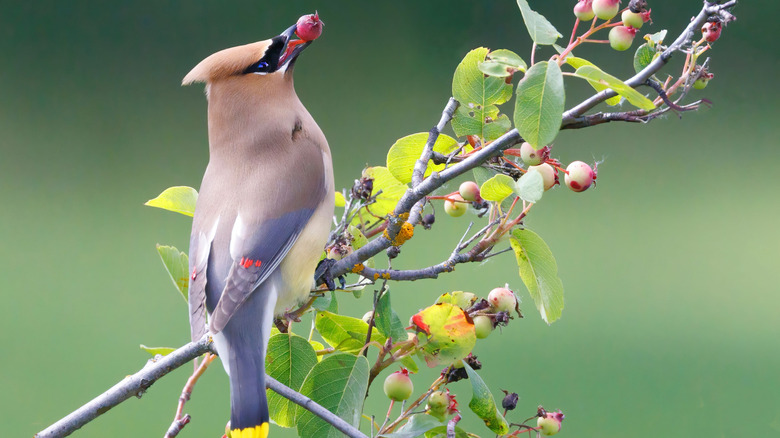What You Need To Know Before Using Fruit And Seed Blends In Bird Feeders
We may receive a commission on purchases made from links.
Whether you're sitting on a sunny patio in the morning or looking out a kitchen window while doing the dishes at night, watching birds visit your yard is one of life's little pleasures. Although there are many perennial plants you can add to your yard to attract birds year-round, birdscaping with a variety of feeder types is also likely to bring more feathered friends around to visit. Whether you love big red cardinals, tiny chickadees, or colorful finches, once you get the birdwatching bug, it doesn't take long to become overwhelmed at the wide variety of bird seeds available. Along with classic choices like sunflower seeds and suet, you'll also find several fruit and seed blends on the shelves. House Digest spoke with Jennifer Tyrell, Program Manager for Community Science and Research at Audubon South, in an exclusive interview to find out exactly what you need to know before using a fruit and seed blend in your bird feeder.
"Having a variety of feeds, including fruit, can attract different birds to your yard," Tyrell told us, adding, "Fruit blends may be a good choice for backyard birds, and attract birds like nuthatches, woodpeckers, chickadees, cardinals, and grosbeaks." The National Audubon Society, a nonprofit organization dedicated to the conservation and protection of birds, makes a fruity bird seed blend that contains raisins and cherries. Kaytee Nut & Fruit Wild Bird Seed is another extremely popular choice with birders, who say their feeders are always full when this treat is offered.
How to birdscape your backyard with feeders
Planting native species that birds can use for shelter, providing ample nesting material, and offering a birdbath in a shaded location are just a few of the many important tips for turning your yard and garden into a bird haven. In her exclusive interview with House Digest, Tyrell says that filling your feeders with the right nutrition for the birds you already have, or want to attract, is another critically important step. But she offered some words of caution if you decide on a fruit and seed mix: "Fruit seed blends do exist, though as with all feeders, you should be careful to make sure that the feed is fresh and does not get moldy."
There are several ways to do this. First, regularly clean your bird feeders, scrubbing them with a solution of two ounces of bleach in a gallon of water before letting them dry in the sun. Second, only use bird seed that's been properly stored in a cool, dry place. It should stay fresh for six to 12 months. "In some more humid climates, the fruit in the seed blend may spoil more quickly than nuts and seeds," Tyrell warned us. When it's time for a refill, only fill your feeders halfway to improve airflow and reduce seed waste. Spoiled seed can cause digestive problems that can lead to your patio being covered with bird poop, and can even cause bird fatalities. Toss any suspicious seed that looks clumpy or smells like mildew.
You can offer fruity alternatives, too
If you're too birdbrained to consistently fill your feeders, worried about feeders attracting squirrels or rodents, or just want to create a more permanent food source in your backyard, there are alternatives to offering fruit and seed blends. "A great way that helps birds and their habitats is to plant native plants that grow fruit," Tyrell told House Digest during her exclusive interview. "Native plants help both native and migratory species find the food they need, and seeking out fruit plants can bring a wider variety of birds to your yard." From elderberries to pawpaw fruits, cherries to crabapples, there are dozens of fruit and berry trees to grow in your yard that birds love.
Tyrell said you can also offer other alternatives to fruit seed blends by setting out jellies or fresh fruit. This is a great approach if you can't afford fancy feeders or big bags of seed, and want to DIY feeders to attract birds on a budget. "Mixed berry and grape jelly is great for orioles," Tyrell said, "and some warblers like Black-throated Blue Warblers also love jellies."
Along with the bliss of birdwatching, feeding and caring for birds is critical to their survival. According to Tyrell, bird populations are in serious decline. The experts at Audubon attribute this to habitat loss and climate change. They encourage everyone to plant native species to help birds find the resources they need to survive. You can find a list of native plants that are suitable for birds on the official Audubon website.


